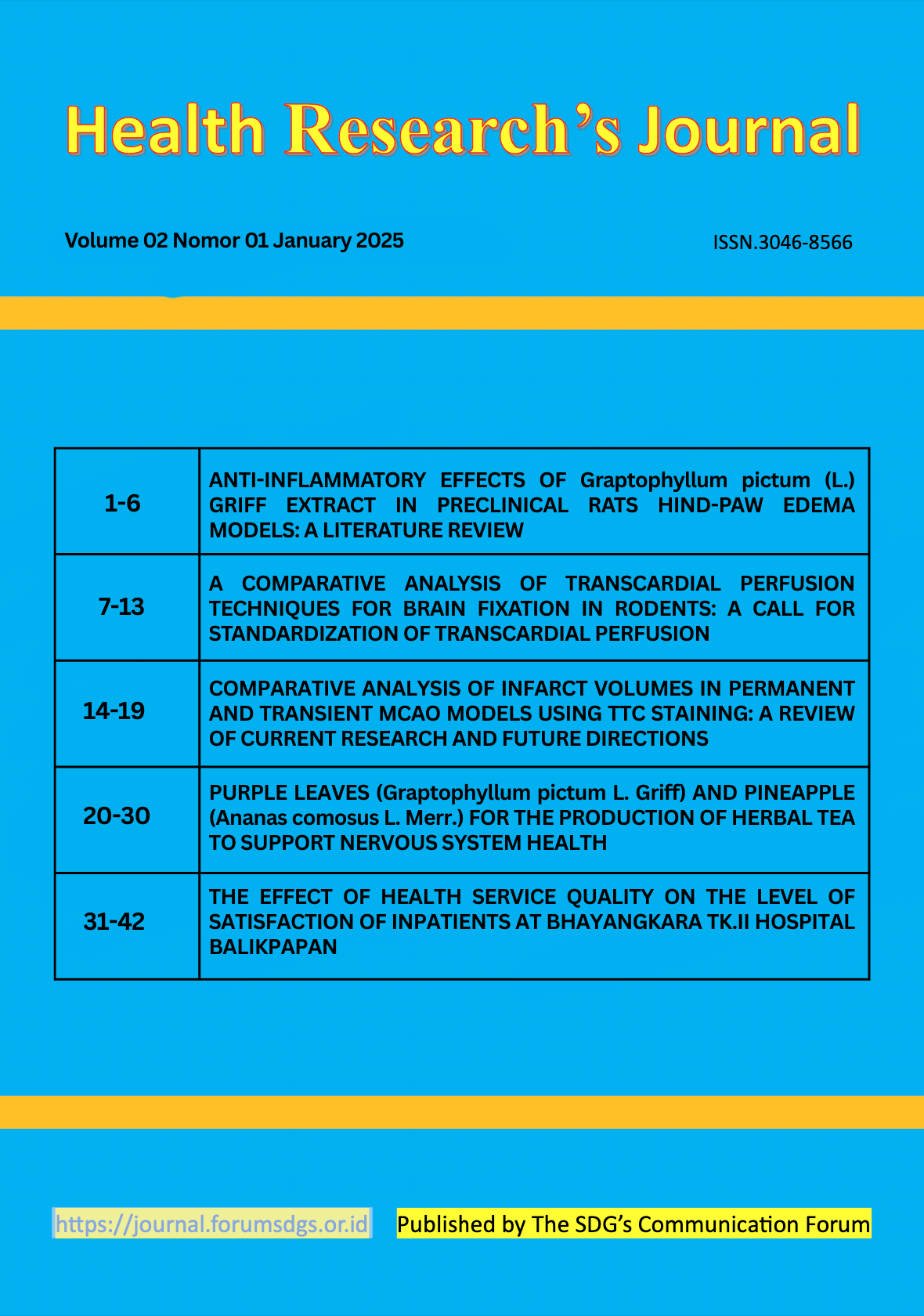COMPARATIVE ANALYSIS OF INFARCT VOLUMES IN PERMANENT AND TRANSIENT MCAO MODELS USING TTC STAINING: A REVIEW OF CURRENT RESEARCH AND FUTURE DIRECTIONS
DOI:
https://doi.org/10.00000/js818616Keywords:
Middle Cerebral Artery Occlusion (MCAO), Permanent MCAO, Transient MCAO, TTC Staining, Stroke Research ModelsAbstract
Ischemic stroke research often relies on animal models to understand the pathological processes underlying brain injury. Among the most widely used models are permanent middle cerebral artery occlusion (pMCAO) and transient middle cerebral artery occlusion (tMCAO), both of which simulate ischemic events in the brain. However, while existing studies have compared the effects of pMCAO and tMCAO on infarct volumes, many have been limited by short observation periods (e.g., 4 hours) or have focused only on non-occlusion models. This literature review aims to evaluate the comparative effectiveness of these two models in generating infarct sizes, specifically utilizing triphenyltetrazolium chloride (TTC) staining to measure infarct volumes. Our analysis highlights the variability in infarct volumes between the two models and emphasizes further research incorporating longer observation intervals (e.g., 6, 18, and 24 hours). This gap in research is crucial for refining experimental stroke models and improving the clinical relevance of findings, particularly regarding therapeutic strategies for ischemic stroke. The review also suggests potential research pathways to enhance model standardization and consistency in future studies, aiming for more accurate and reproducible results that will inform the development of effective stroke treatments.
References
Benedek, A. et al. (2006) ‘Use of TTC staining for the evaluation of tissue injury in the early phases of reperfusion after focal cerebral ischemia in rats’, Brain Research, 1116(1), pp. 159–165. Available at: https://doi.org/10.1016/j.brainres.2006.07.123.
Biose, I.J. et al. (2022) ‘Optimizing intraluminal monofilament model of ischemic stroke in middle-aged Sprague–Dawley rats’, BMC Neuroscience, 23(1), p. 75. Available at: https://doi.org/10.1186/s12868-022-00764-2.
Feigin, V.L. et al. (2021) ‘Global, regional, and national burden of stroke and its risk factors, 1990–2019: a systematic analysis for the Global Burden of Disease Study 2019’, The Lancet Neurology, 20(10), pp. 795–820. Available at: https://doi.org/10.1016/S1474-4422(21)00252-0.
He, Y. et al. (2022) ‘Evaluating blood-brain barrier disruption and infarction volume concurrently in rats subjected to ischemic stroke using an optical imaging system’, Journal of Neuroscience Methods, 378, p. 109630. Available at: https://doi.org/10.1016/j.jneumeth.2022.109630.
Kuts, R. et al. (2019) ‘A Novel Method for Assessing Cerebral Edema, Infarcted Zone and Blood-Brain Barrier Breakdown in a Single Post-stroke Rodent Brain’, Frontiers in Neuroscience, 13, p. 1105. Available at: https://doi.org/10.3389/fnins.2019.01105.
Li, L., Yu, Q. and Liang, W. (2018a) ‘Use of 2,3,5-triphenyltetrazolium chloride-stained brain tissues for immunofluorescence analyses after focal cerebral ischemia in rats’, Pathology - Research and Practice, 214(1), pp. 174–179. Available at: https://doi.org/10.1016/j.prp.2017.11.016.
Li, L., Yu, Q. and Liang, W. (2018b) ‘Use of 2,3,5-triphenyltetrazolium chloride-stained brain tissues for immunofluorescence analyses after focal cerebral ischemia in rats’, Pathology - Research and Practice, 214(1), pp. 174–179. Available at: https://doi.org/10.1016/j.prp.2017.11.016.
Liu, P. et al. (2024) ‘Establishment of a pMCAO model in SD rats and screening for behavioral indicators suitable for long-term monitoring’, Brain Injury, 38(9), pp. 716–726. Available at: https://doi.org/10.1080/02699052.2024.2346804.
McBride, D.W. and Zhang, J.H. (2017) ‘Precision Stroke Animal Models: the Permanent MCAO Model Should Be the Primary Model, Not Transient MCAO’, Translational Stroke Research, 8(5), pp. 397–404. Available at: https://doi.org/10.1007/s12975-017-0554-2.
Peng, J. et al. (2022) ‘Advancement of epigenetics in stroke’, Frontiers in Neuroscience, 16, p. 981726. Available at: https://doi.org/10.3389/fnins.2022.981726.
Sanchez-Bezanilla, S. et al. (2019) ‘Can We Use 2,3,5-Triphenyltetrazolium Chloride-Stained Brain Slices for Other Purposes? The Application of Western Blotting’, Frontiers in Molecular Neuroscience, 12, p. 181. Available at: https://doi.org/10.3389/fnmol.2019.00181.
Santo, B.A. et al. (2023) ‘Tectonic infarct analysis: A computational tool for automated whole-brain infarct analysis from TTC-stained tissue’, Heliyon, 9(4), p. e14837. Available at: https://doi.org/10.1016/j.heliyon.2023.e14837.
Si, Z. et al. (2019) ‘Effects of thrombolysis within 6 hours on acute cerebral infarction in an improved rat embolic middle cerebral artery occlusion model for ischaemic stroke’, Journal of Cellular and Molecular Medicine, 23(4), pp. 2468–2474. Available at: https://doi.org/10.1111/jcmm.14120.
Wang, Y. et al. (2023) ‘The superiority and feasibility of 2,3,5‐triphenyltetrazolium chloride–stained brain tissues for molecular biology experiments based on microglial properties’, Animal Models and Experimental Medicine, 6(2), pp. 111–119. Available at: https://doi.org/10.1002/ame2.12312.
Wells, A.J. et al. (2012) ‘A Surgical Model of Permanent and Transient Middle Cerebral Artery Stroke in the Sheep’, PLoS ONE. Edited by C. Kleinschnitz, 7(7), p. e42157. Available at: https://doi.org/10.1371/journal.pone.0042157.
Zemgulyte, G. et al. (2021) ‘Evaluation of the Effectiveness of Post-Stroke Metformin Treatment Using Permanent Middle Cerebral Artery Occlusion in Rats’, Pharmaceuticals, 14(4), p. 312. Available at: https://doi.org/10.3390/ph14040312.
Zhang, K.-Y. et al. (2020) ‘Cathodal tDCS exerts neuroprotective effect in rat brain after acute ischemic stroke’, BMC Neuroscience, 21(1), p. 21. Available at: https://doi.org/10.1186/s12868-020-00570-8.


